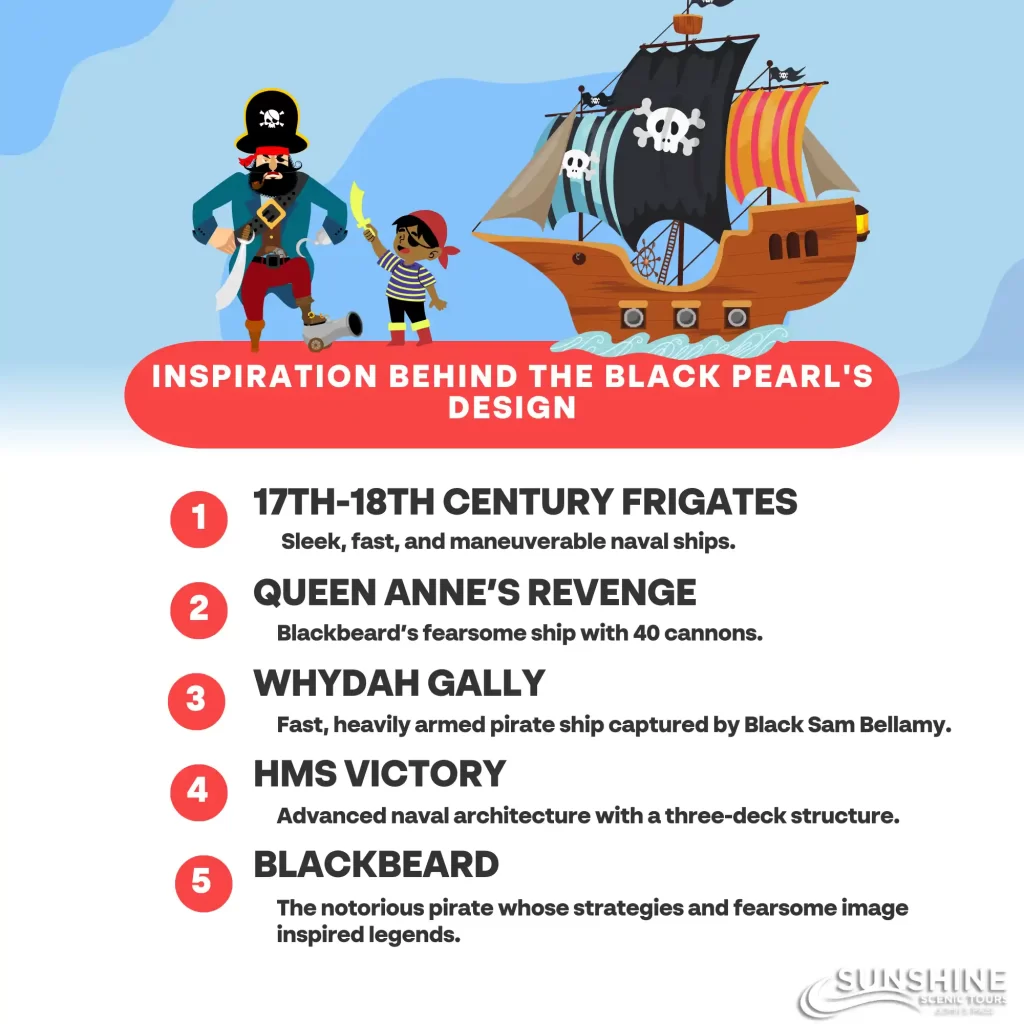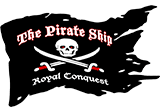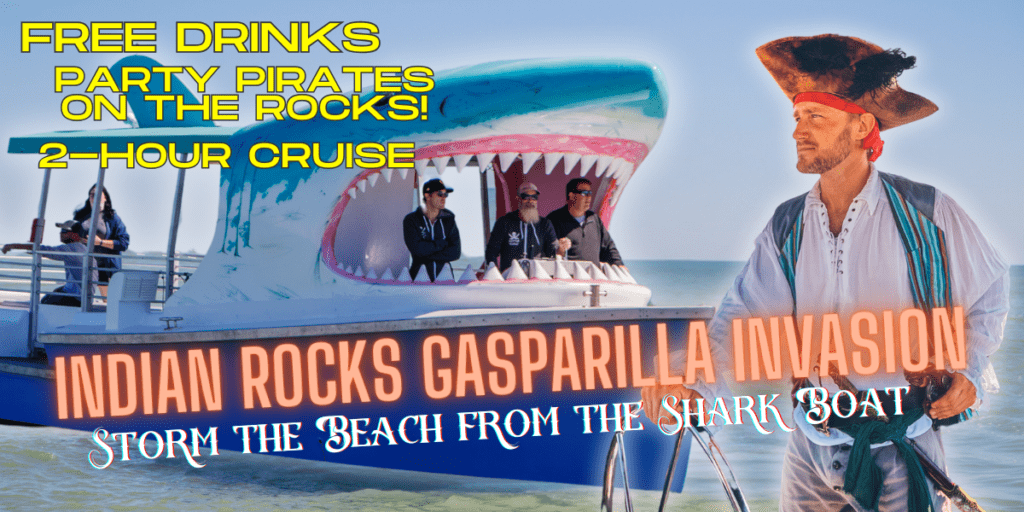The Black Pearl’s design pulls from the sleek frigates of the 17th and 18th centuries, known for their elongated hulls and towering masts. It echoes legends like Blackbeard’s Queen Anne’s Revenge, a formidable pirate ship armed with 40 guns, and the Whydah Gally, noted for its speed. Even the HMS Victory’s intricate architecture left a mark. Blackbeard himself, a feared pirate, further romanticizes the lore with his strategic genius. As you trace the evolution from naval engineering to pirate legends, you’ll discover the compelling merge of reality and myth that inspired the Black Pearl.

Key Takeaways
- The Black Pearl’s design is inspired by 17th and 18th-century sleek frigates known for speed and maneuverability.
- Its elongated hull and towering masts mirror the naval architecture of historical frigates.
- The dark hull reflects traditional methods to protect ships from seawater damage.
- Features like the raised quarterdeck and forecastle draw from matured naval engineering principles.
- Pirate ships like Blackbeard’s Queen Anne’s Revenge influenced its fearsome reputation and firepower.
Historical Naval Influence
The Black Pearl‘s design draws heavily from historical naval architecture, specifically the sleek and swift frigates of the 17th and 18th centuries that dominated the high seas. When you examine the Black Pearl ship, you’ll notice its distinctive, elongated hull and towering masts, which are hallmarks of these historical vessels. These design elements were pivotal for achieving high speeds and maneuverability, necessary for both trade and warfare during that era.
In the early 1600s, frigates emerged as a versatile class of warship, combining firepower with agility. By the mid-18th century, their design had evolved to include a raised quarterdeck and forecastle, providing better vantage points and additional space for crew and weaponry. The Black Pearl mirrors these features with its elevated decks and formidable array of cannons.
Moreover, the ship’s dark hull isn’t just for dramatic effect. Many historical ships were coated in pitch or black paint to protect the wood from seawater, reflecting a practical application of historical naval influence. By the late 1700s, these design principles reached their peak, and the Black Pearl encapsulates this matured, efficient form of naval engineering, blending historical accuracy with cinematic flair.
Queen Anne’s Revenge
You can’t talk about the Black Pearl without first considering Queen Anne’s Revenge, Blackbeard’s legendary ship that set the standard for pirate vessels. Starting with its formidable design, the ship was heavily armed and modified for intimidation and speed, elements vital for a pirate’s success. Historically, Queen Anne’s Revenge played a pivotal role in the early 18th century, capturing the imagination and fear of sailors and serving as a direct inspiration for fictional pirate ships like the Black Pearl.
Blackbeard’s Legendary Ship
Among the most notorious pirate ships in history, Blackbeard’s Queen Anne’s Revenge looms large, its fearsome reputation and storied past setting the stage for countless maritime legends. The Queen Anne’s Revenge began its life as a French slave ship named La Concorde. In late 1717, Blackbeard captured La Concorde near the island of Martinique, subsequently renaming it and transforming it into his flagship. Armed with 40 guns, the Queen Anne’s Revenge became a formidable presence on the high seas.
You might wonder, was the Black Pearl a real ship, and did it draw inspiration from such legendary vessels? The Black Pearl ship, famous in popular culture, shares similarities with Blackbeard’s Queen Anne’s Revenge. Both ships are characterized by their formidable firepower, notorious captains, and a reputation that struck fear in the hearts of sailors.
Chronologically, after its capture, the Queen Anne’s Revenge played a pivotal role in Blackbeard’s pirate activities. It blockaded the port of Charleston, South Carolina, in May 1718, showcasing its menacing capabilities. However, its reign was short-lived. In June 1718, the ship ran aground off the coast of North Carolina, marking the end of its brief yet impactful journey.
Pirate Ship’s Design
As Blackbeard’s Queen Anne’s Revenge shifted from a captured French slave ship to a fearsome pirate flagship, its design underwent significant modifications that improved its combat capabilities and intimidating presence on the high seas. Initially, when Blackbeard seized the French vessel La Concorde in 1717, its primary function was to transport slaves. You’d find that its layout was utilitarian, optimized for cargo space rather than combat.
The first major alteration was the reinforcement of the hull. This made the ship more resilient during battles. Next, Blackbeard added numerous cannons, transforming it into a floating fortress. The Queen Anne’s Revenge was equipped with up to 40 cannons, strategically placed to maximize firepower.
Additionally, the ship’s rigging and sails were modified for increased speed and maneuverability. This allowed the vessel to chase down targets and evade pursuers more effectively. Blackbeard also adorned the ship with menacing decorations, such as skull-and-crossbones flags and dark paint, to instill fear in his enemies.
Historical Significance
In examining the historical significance of the Queen Anne’s Revenge, understanding how this notorious vessel became an enduring symbol of piracy during the Golden Age of Piracy is vital. Originally a French slave ship named La Concorde, it was captured by the infamous pirate Blackbeard in 1717. Renaming it the Queen Anne’s Revenge, Blackbeard refitted the ship with 40 cannons, making it one of the most formidable pirate ships of its time.
Starting with its capture, the vessel quickly became synonymous with terror on the high seas. Blackbeard’s strategic use of the ship allowed him to blockade the port of Charleston in 1718, a bold move that demonstrated the ship’s power and his audacity. This event cemented its fearsome reputation and highlighted the strategic importance of a well-armed ship in pirate lore.
The Whydah Gally
You might find it fascinating that the Whydah Gally, originally a slave ship, was captured by the infamous pirate Captain ‘Black Sam’ Bellamy in 1717, marking the beginning of its transformation into one of the most legendary pirate vessels in history. Initially designed to transport slaves, this ship was fast and heavily armed, making it an ideal target for pirates. Bellamy seized the Whydah and immediately set about modifying it for piracy.
Under Bellamy’s command, the Whydah Gally became a symbol of pirate ingenuity and ferocity. The ship’s speed and firepower allowed Bellamy and his crew to execute successful raids along the American coast and the Caribbean. Bellamy’s egalitarian leadership style led to a well-organized and loyal crew, enhancing the Whydah’s effectiveness.
Tragically, the Whydah’s journey was cut short when it encountered a powerful Nor’easter off the coast of Cape Cod in April 1717. The storm wrecked the ship, claiming many lives and scattering its treasure. Despite its brief career, the Whydah Gally’s legacy endures, influencing pirate lore and even modern pop culture, including the design of fictional ships like the Black Pearl.
HMS Victory’s Design
While the Whydah Gally stands as a tribute to pirate ingenuity, HMS Victory‘s design showcases the pinnacle of naval architecture and military engineering in the 18th century. Launched in 1765, the HMS Victory embodied advancements in shipbuilding that were revolutionary for its time. You’d first notice its three-deck structure, designed to carry over 100 guns, making it a formidable force in naval warfare.
The keel was laid with English oak, known for its strength and durability. This choice of material wasn’t just for longevity but also for withstanding the rigors of battle. HMS Victory’s hull was designed with a broad beam to ensure stability, essential for a ship of its size and armament.
Moving upwards, the ship’s rigging was a complex arrangement of ropes and sails, allowing for impressive maneuverability despite its massive size. The masts, made from pine, supported an intricate sail plan that maximized wind capture, crucial for both speed and tactical positioning.
Internally, the deck layout was meticulously planned, with the lower decks housing cannons and the upper decks reserved for the crew and officers. This design facilitated efficient combat operations and quick responses during naval engagements.
The Real Blackbeard
You can’t discuss the Black Pearl without first exploring the pirate origins of Blackbeard, born Edward Teach around 1680. His notorious acts, such as the blockade of Charleston Harbor in 1718, cemented his fearsome reputation. Finally, Blackbeard’s reign of terror ended in a brutal battle with Lieutenant Robert Maynard in November 1718.
Pirate Origins Explored
In delving into the pirate origins of the infamous Blackbeard, one must first examine the early 18th century, a period rife with naval conflicts and maritime lawlessness that shaped his legendary career. Born around 1680, likely in Bristol, England, Blackbeard, whose real name was Edward Teach (or Thatch), emerged from a society where seafaring was a common livelihood. The War of Spanish Succession (1701-1714) provided him with vital naval experience, as privateers were sanctioned to attack enemy ships.
After the war ended, many privateers turned to piracy, unable to find legitimate employment. Teach was no exception. By 1716, he had joined the crew of Benjamin Hornigold, a notorious pirate captain, and quickly ascended the ranks due to his maritime prowess and fearsome demeanor.
By 1717, Teach commanded his own vessel, Queen Anne’s Revenge, and adopted the moniker Blackbeard, instilling fear across the Caribbean and Atlantic.
To understand Blackbeard’s transformation, consider these pivotal moments:
- The end of the War of Spanish Succession – left many seafarers unemployed.
- Joining Benjamin Hornigold’s crew – provided essential pirate training.
- Commanding Queen Anne’s Revenge – symbolized his rise in power.
- Adopting the name Blackbeard – marked his fearful reputation.
These events collectively forged the terrifying pirate known today.
Notorious Pirate Acts
Throughout his notorious career, Blackbeard committed numerous acts of piracy that not only cemented his fearsome reputation but also demonstrated his cunning and ruthlessness on the high seas. In 1717, he captured a French slave ship, which he renamed Queen Anne’s Revenge, transforming it into his flagship. This marked the beginning of a reign of terror along the American coastline.
Blackbeard’s strategic acumen was evident in his blockade of Charleston, South Carolina, in May 1718. He seized several ships and held the city’s entire harbor hostage, demanding a chest of medicine in exchange for the safe release of hostages. This act showcased his ability to paralyze a major port and negotiate on his terms.
In the same year, Blackbeard executed a daring raid on the port of Beaufort, North Carolina. He captured numerous vessels, adding to his growing fleet. His manipulation of alliances and betrayals, like his brief collaboration with pirate Stede Bonnet, further highlighted his strategic mind.
Blackbeard’s Final Battle
As Blackbeard’s reign of terror continued to plague the American coastline, his final battle in November 1718 would ultimately seal his fate and cement his legacy as one of history’s most infamous pirates. The encounter took place off Ocracoke Island, where Blackbeard’s ship, Adventure, was anchored. Lieutenant Robert Maynard of the Royal Navy, dispatched by Virginia Governor Alexander Spotswood, led the assault with two sloops, Jane and Ranger.
The battle began at dawn on November 22, 1718. Maynard’s forces approached under the cover of darkness, catching Blackbeard off guard. When the ships collided, a fierce hand-to-hand combat ensued. Blackbeard fought ferociously, but the numbers were against him. He sustained multiple wounds before finally succumbing to a fatal blow from Maynard.
The aftermath of the battle was grisly:
- Blackbeard’s Head: Maynard decapitated Blackbeard, hanging his head from the bowsprit as a grim trophy.
- Casualties: Blackbeard’s crew suffered heavy losses, with many killed or captured.
- Loot: The Royal Navy seized Blackbeard’s treasure, a stark reminder of his plundering days.
- Legacy: The battle marked the end of an era, forever enshrining Blackbeard in pirate lore.
This climactic confrontation highlights the brutal reality of piracy and the relentless pursuit of justice.
The Golden Age of Piracy
During the early 18th century, the Caribbean became a notorious hotspot for piracy, setting the stage for some of the most legendary pirate figures and tales that would inspire the Black Pearl’s creation. By the 1710s, the Caribbean Sea was teeming with pirates. The War of Spanish Succession had just ended, leaving many privateers unemployed. These sailors, skilled in naval combat, turned to piracy as a means of survival.
You’ll see that piracy flourished due to several factors: the lucrative shipping lanes, the abundance of isolated islands for hideouts, and the weakness of European naval forces stretched thin across vast colonial empires. Pirates like Charles Vane and “Calico” Jack Rackham began their reigns of terror, capturing merchant vessels and amassing wealth.
Caribbean Pirate Legends
Often enchanting the imaginations of those who hear their tales, Caribbean pirate legends reveal a treasure trove of notorious figures whose daring exploits and cunning strategies have shaped the mythos surrounding the Black Pearl. These stories, steeped in both fact and fiction, bring to life the adventurous spirit of the high seas during the Golden Age of Piracy.
- Blackbeard (Edward Teach): In the early 1700s, Blackbeard terrorized the Caribbean with his fearsome appearance and ruthless tactics. His flagship, Queen Anne’s Revenge, struck fear into the hearts of sailors and merchants alike.
- Anne Bonny and Mary Read: These two women disguised themselves as men and joined pirate crews in the early 18th century. Their bravery and combat skills earned them a place in pirate lore.
- Calico Jack (John Rackham): Known for his flamboyant clothing and the Jolly Roger flag, Calico Jack operated in the early 1700s. His pirate code and leadership style left a lasting legacy.
- Henry Morgan: Operating in the mid-1600s, Morgan was both a pirate and a privateer. His raids on Spanish settlements were legendary, leading to his eventual knighthood by the English crown.
These legends offer a rich tapestry of adventure, fear, and intrigue that continue to captivate audiences today.
Influence of Pirate Myths
Building on the rich tapestry of legendary pirates like Blackbeard, Anne Bonny, and Henry Morgan, you’ll find their larger-than-life personas have profoundly influenced the myths that continue to shape our understanding of pirate lore today. Starting with the 18th century, tales of Blackbeard’s fearsome appearance and cunning strategies were circulated widely, embedding the image of the quintessential pirate in public imagination. His real name, Edward Teach, became synonymous with terror on the high seas, and his flag—a skull with crossed bones—became iconic.
Moving into the early 1700s, Anne Bonny’s story emerged, challenging gender norms and depicting a fiercely independent woman who fought alongside male pirates. Her exploits with Calico Jack Rackham added layers of intrigue and romance, further embellishing pirate mythology.
Shipwreck Discoveries
Many of the most fascinating insights into pirate life have come from the meticulous study of shipwreck discoveries, which offer tangible evidence of the maritime world that once dominated the high seas. These underwater time capsules help piece together the daily existence of seafarers and their vessels.
- Queen Anne’s Revenge (1996): Discovered off the coast of North Carolina, this infamous shipwreck, once captained by Blackbeard, provided vital details about pirate weaponry, including cannons and ammunition, as well as personal items like belt buckles and medical supplies.
- Whydah Gally (1984): Found off Cape Cod, this was the first authenticated pirate shipwreck in North America. It revealed gold coins, jewelry, and a wealth of artifacts that illustrated the wealth pirates could amass and the diverse origins of their plundered goods.
- San José (2015): Off the coast of Colombia, this Spanish galleon yielded a staggering trove of gold, silver, and emeralds, shedding light on the immense riches transported across the Atlantic and targeted by pirates.
- Batavia (1963): Located off Western Australia, it offered a glimpse into the brutal reality of maritime survival and mutiny, with remains of the crew and passengers underscoring the perilous nature of 17th-century voyages.
These discoveries collectively enrich our understanding of pirate life and their enduring legacy.
Pirate Ship Restoration
As shipwreck discoveries continue to reveal the secrets of pirate life, the detailed process of pirate ship restoration emerges as a vital endeavor to preserve and understand these maritime relics. First, you’ll need to carefully document the shipwreck site, capturing every detail through photographs and sketches. This initial step is pivotal as it provides an extensive reference before any physical intervention begins.
Next, you’ll move to the excavation phase, where specialized tools are used to gently unearth the remnants. It’s a meticulous process, requiring precision to avoid damaging fragile artifacts. Once the remains are safely transported to a conservation facility, the real restoration work begins.
You’ll start by desalinating the wooden structures, a process that can take months or even years. Removing the salt prevents future deterioration. Simultaneously, you’ll employ chemical treatments to stabilize metals and other materials found on the ship.
Conclusion
In delving into the daring designs and dramatic tales behind the Black Pearl, you’ll discover its roots in historical naval influence and infamous ships like Queen Anne’s Revenge and The Whydah Gally. From the formidable HMS Victory’s design to the fierce real-life Blackbeard, the Pearl’s legacy is layered with Caribbean pirate legends. Pirate myths merge with modern shipwreck discoveries and meticulous restorations, painting a vivid, chronological picture of a pirate ship’s storied past.







